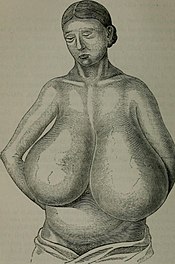Breast reduction surgery as the name implies, is a plastic surgery procedure that is carried out to reduce the size of disproportionate large breasts. It is also known as reduction mammoplasty.
The operation involves the removal of excess fat, tissue and skin from the abnormally large breasts.
Read: What is Breat Augmentation Surgery?
Why the Surgery is Carried Out
Breast reduction surgery is carried out for three major reasons:
1. Physical – Macromastia is an indication of breast reduction surgery. This is a rare medical condition of the breast connective tissues in which the breasts become excessively large. Macromastia may be caused by increased sensitivity of the breast tissues to certain hormones such as female sex hormones, prolactin, and growth factors.

Macromastia
Some women opt for the surgical procedure due to reduce the discomfort and pains as the abnormally enlarged breasts may cause:
– Chronic pain to the head, neck, shoulders and back
– Poor blood circulation
– Impaired breathing
– Improper fit of clothes
2. Aesthetic – Breast reduction surgery is also carried out to improve the beauty and self-image of the woman.
3. Psychological – Macromastia may cause significant psychological stress in the sufferers. Reduction mammoplasty is therefore carried out to improve the mental health of the patient.
Surgical Procedure
1. Pre-operative Matters
Prior to breast reduction surgery, the medical records of the patient are taken. These include:
– Number of children she has borne
– Breast-feeding practices
– Plans for pregnancy
– Medical allergies
– Smoking habits
– Surgical history of breast surgery
– Family history of breast cancer
The surgeon may take photos of your breasts, measure them, and talk with you about how much breast tissue will need to be removed to achieve your goal.
After taking the medical records, your surgeon will instruct you about the purposes of the breast reduction surgery, the achievable corrections and the expected final size, shape and feel of the corrected breasts and possible medical complications.
2. Operative Technique
Breast reduction surgery may be carried out using either Incision-plan Delineation technique or Liposuction-only technique.
The surgical method depends on a lot of factors which the surgeons will inform you about before the operation is carried out.
Liposuction-only technique is used when a minor-to-moderate reduction is required and there is no breast sagging to correct. Otherwise, Incision-plan Delineation technique will be used.
The patient is laid horizontally upon the operating table with the face and torso facing up so that the surgeon can later raise her to a sitting position that will allow visual comparison of the drape of the breasts, and an accurate assessment of the post-operative symmetry of the reduced and lifted bust.
The surgeon usually:
- Makes an incision around the areola and down each breast
- Removes excess breast tissue, fat and skin to reduce the size of each breast
- Reshapes the breast and repositions the nipple and areola.
3. Post-Operative Matters – What to expect After Breast Reduction surgery
The woman is instructed to resume her normal life activities after breast reduction reduction with specific instructions to prevent complications. A day after the operation, you need to eat a light diet and stay away from the shower.
You will need to take at least one week off from work or school after breast reduction surgery.
Try to avoid strenuous physical activity and wear a sports brassiere. The recovery plan for breast reduction surgery is for 3-months after the operation.
The surgical scar usually fades within 1-6 months, however, Scheduled follow-up consultations ensure a satisfactory outcome to the breast reduction surgery, and facilitate the early identification and management of medical complications.
Complications of Breast Reduction Surgery
Some complications may arise following reduction mammoplasty. They include:
- Infections – Like most other surgical procedures, there is tendency for the operated area to become infected with pathogens such as bacteria, etc.
- Bleeding – There may be post-operative bleeding after breast reduction surgery.
- Seroma – This is the accumulation of serous fluid within the breast.
- Hematoma – This is a collection of blood within the breast.
- Wound Dehiscence – This is a surgical complication in which a wound ruptures along the surgical incision.
Contact your doctor immediately at the first sign of infection, including redness, tenderness or unusual swelling at the surgical site, or fever.


